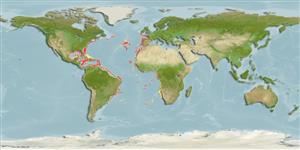>
Scombriformes (Mackerels) >
Trichiuridae (Cutlassfishes) > Aphanopodinae
Etymology: Aphanopus: Greek, aphanes = hidden + Greek, pous = foot (Ref. 45335).
Environment: milieu / climate zone / depth range / distribution range
Ecologia
marino benthopelagico; distribuzione batimetrica 300 - 1408 m (Ref. 6181). Deep-water; 50°N - 35°S, 105°E - 14°E (Ref. 6181)
Atlantic Ocean: in moderately warm and tropical waters; it has not been found only off the coast of South America. In the eastern Atlantic, it is found off western Sahara, Congo and Angola, from Sierra Leone submarine rise and Pilberry Seamount (Ref. 10818).
Size / Peso / Age
Maturity: Lm ? range ? - ? cm
Max length : 148 cm TL maschio/sesso non determinato; (Ref. 108735)
Short description
Morfologia | Morfometria
Spine dorsali (totale): 39 - 44; Raggi dorsali molli (totale): 54-59; Spine anali 2; Raggi anali molli: 46 - 50; Vertebre: 102 - 108. Pelvic fins represented by a single spine in juveniles inserted before the base of the pectoral fins but entirely absent in adults. Body is coppery black with iridescent tint. The inside of the mouth and gill cavities black.
Adults benthopelagic from 800 to 1,350 m, juveniles mesopelagic from 300 to 500 m (Ref. 6181). Up until recently, fisheries catch landings of A. carbo, a sympatric species in the waters of Canary and Madeira islands, were mixed with A. intemedius.
Life cycle and mating behavior
Maturità | Riproduzione | Deposizione | Uova | Fecundity | Larve
Displays determinate fecundity (Ref. 108695). Mature individuals undertake horizontal migration to spawning and nursery grounds (Ref. 108708).
Nakamura, I. and N.V. Parin, 1993. FAO Species Catalogue. Vol. 15. Snake mackerels and cutlassfishes of the world (families Gempylidae and Trichiuridae). An annotated and illustrated catalogue of the snake mackerels, snoeks, escolars, gemfishes, sackfishes, domine, oilfish, cutlassfishes,. scabbardfishes, hairtails, and frostfishes known to date. FAO Fish. Synop. 125(15):136 p. (Ref. 6181)
IUCN Red List Status (Ref. 130435)
Threat to humans
Harmless
Human uses
Pesca: commerciale
Informazioni ulteriori
BibliografiaAcquacolturaProfilo di acquacolturaVarietàGeneticaElectrophoresesEreditarietàMalattieElaborazioneNutrientsMass conversion
CollaboratoriImmaginiStamps, Coins Misc.SuoniCiguateraVelocitàModalità di nuotoArea branchialeOtolithsCervelliVista
Strumenti
Special reports
Download XML
Fonti Internet
Estimates based on models
Preferred temperature (Ref.
123201): 6.2 - 13.7, mean 9.4 °C (based on 190 cells).
Phylogenetic diversity index (Ref.
82804): PD
50 = 0.5078 [Uniqueness, from 0.5 = low to 2.0 = high].
Bayesian length-weight: a=0.00110 (0.00059 - 0.00203), b=3.09 (2.92 - 3.26), in cm total length, based on LWR estimates for this species & (Sub)family-body (Ref.
93245).
Trophic level (Ref.
69278): 4.3 ±0.7 se; based on size and trophs of closest relatives
Resilienza (Ref.
120179): Basso, tempo minimo di raddoppiamento della popolazione 4.5 - 14 anni (K=0.121; tmax=15).
Fishing Vulnerability (Ref.
59153): High vulnerability (62 of 100).
Climate Vulnerability (Ref.
125649): Moderate vulnerability (42 of 100).
Nutrients (Ref.
124155): Calcium = 7.2 [3.4, 23.3] mg/100g; Iron = 0.204 [0.058, 0.575] mg/100g; Protein = 15.8 [14.1, 17.6] %; Omega3 = 0.277 [0.112, 0.714] g/100g; Selenium = 42.9 [11.2, 142.5] μg/100g; VitaminA = 11.3 [2.0, 59.4] μg/100g; Zinc = 0.373 [0.178, 0.733] mg/100g (wet weight);
